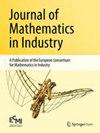基于单相Navier-Stokes方程的浮力驱动钢液搅拌最优控制
IF 1.7
Q3 MATHEMATICS, INTERDISCIPLINARY APPLICATIONS
引用次数: 1
摘要
气体搅拌是二次冶金的重要工艺。它可以使钢液的温度和化学成分均匀化,并去除对最终产品质量有害的夹杂物。在这个过程中,氩气从容器底部的两个喷嘴注入,并通过浮力通过钢液上升,从而引起搅拌,即熔池的混合。在实际应用中,气体流量和喷嘴位置是两个重要的控制参数。为了找到这些控制变量的最优值,采用了一种连续优化方法。在单相不可压缩的纳维-斯托克斯方程中,气体的作用表现为体积力。湍流用Smagorinsky大涡模拟(LES)模型模拟。采用基于涡度的目标泛函来描述液浴中的混合过程。将优化配置与基于工业实践设置的默认配置进行比较。本文章由计算机程序翻译,如有差异,请以英文原文为准。
Optimal control of buoyancy-driven liquid steel stirring modeled with single-phase Navier–Stokes equations
Gas stirring is an important process used in secondary metallurgy. It allows to homogenize the temperature and the chemical composition of the liquid steel and to remove inclusions which can be detrimental for the end-product quality. In this process, argon gas is injected from two nozzles at the bottom of the vessel and rises by buoyancy through the liquid steel thereby causing stirring, i.e., a mixing of the bath. The gas flow rates and the positions of the nozzles are two important control parameters in practice. A continuous optimization approach is pursued to find optimal values for these control variables. The effect of the gas appears as a volume force in the single-phase incompressible Navier–Stokes equations. Turbulence is modeled with the Smagorinsky Large Eddy Simulation (LES) model. An objective functional based on the vorticity is used to describe the mixing in the liquid bath. Optimized configurations are compared with a default one whose design is based on a setup from industrial practice.
求助全文
通过发布文献求助,成功后即可免费获取论文全文。
去求助
来源期刊

Journal of Mathematics in Industry
MATHEMATICS, INTERDISCIPLINARY APPLICATIONS-
CiteScore
5.00
自引率
0.00%
发文量
12
审稿时长
13 weeks
 求助内容:
求助内容: 应助结果提醒方式:
应助结果提醒方式:


